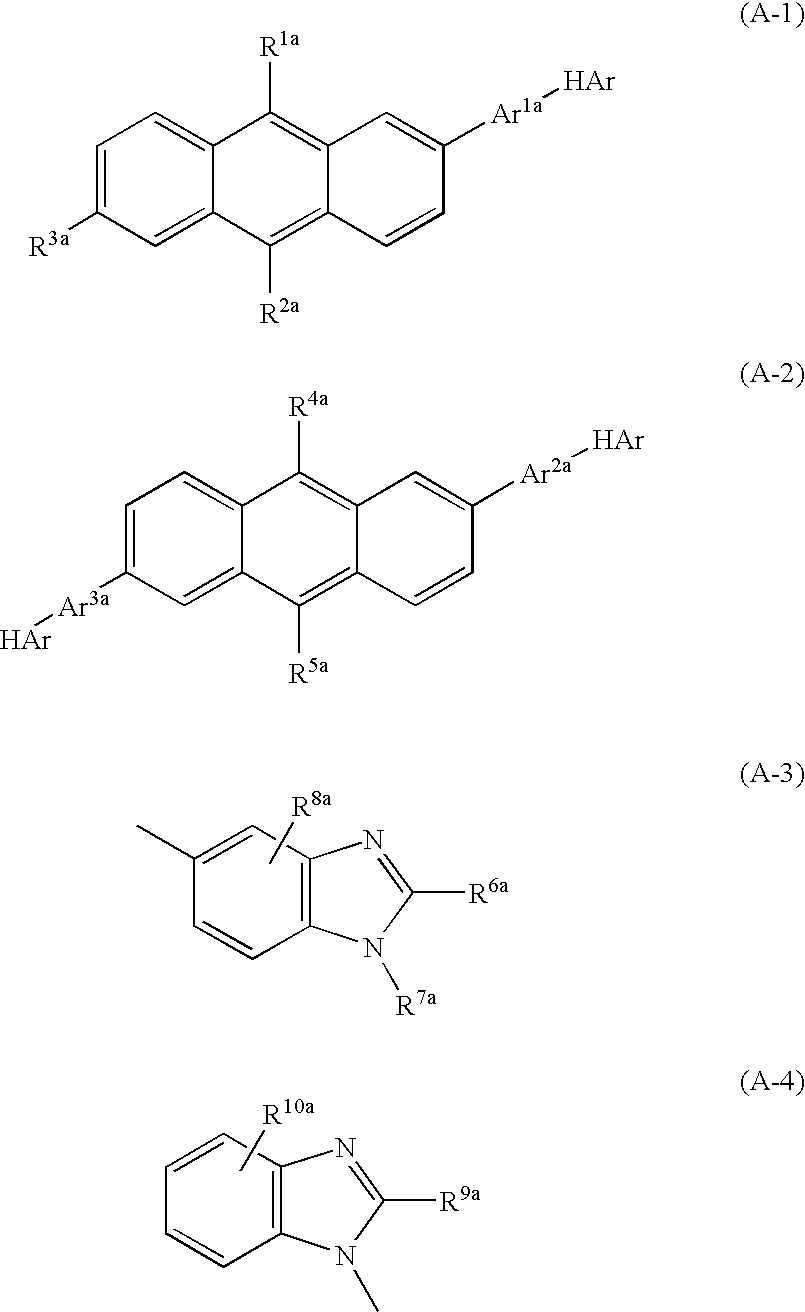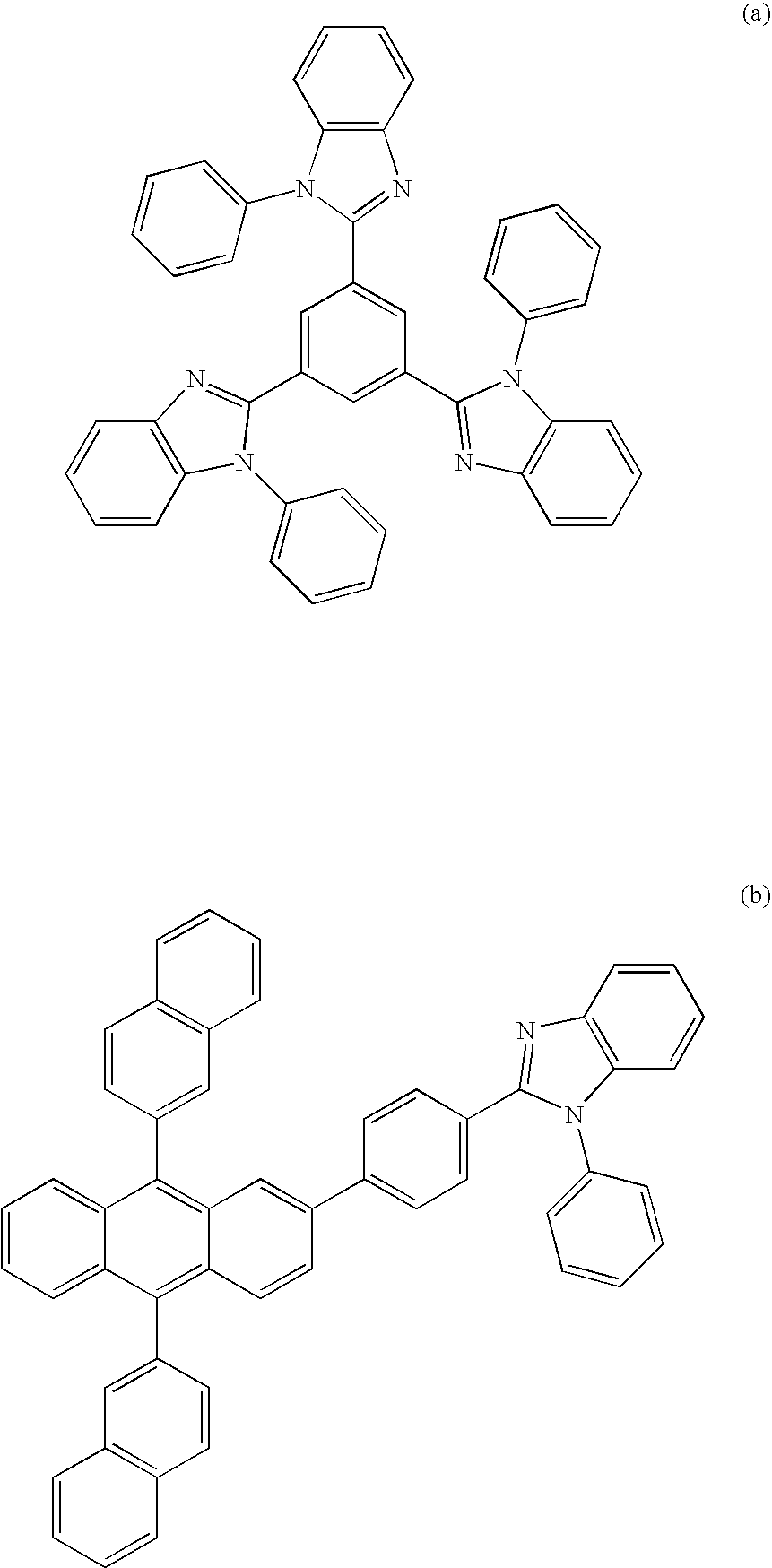Nitrogenous Heterocycle Derivative, And Organic Electroluminescent Element Employing The Same
a heterocycle derivative and organic electroluminescent element technology, applied in the direction of organic semiconductor devices, discharge tube luminescnet screens, organic chemistry, etc., can solve the problem of insufficient light emission efficiency, and achieve the effect of high light emission efficiency and high emission luminan
- Summary
- Abstract
- Description
- Claims
- Application Information
AI Technical Summary
Benefits of technology
Problems solved by technology
Method used
Image
Examples
synthesis example 1
A Compound 1-1 was synthesized as described below.
(1-a) Synthesis of 2-bromoanthraquinone
18 g (81 mmol) of copper bromide and 12 mL (101 mmol) of t-butyl nitrite were dispersed into acetonitrile at 65° C., and then 15 g (67 mmol) of 2-aminoanthraquinone were dropped while the solution was vigorously stirred. The mixture was stirred until the generation of a gas was completely stopped. Then, the temperature of the mixture was cooled to room temperature, and 1 L of 20-mass % hydrochloric acid was added. After that, the resultant was extracted with dichloromethane. An organic layer was dried with magnesium sulfate, and the solvent was distilled off under reduced pressure. The residue was purified by means of silica gel column chromatography to obtain 14 g of 2-bromoanthraquinone (75% yield).
(1-b) Synthesis of 2-bromo-9,10-diphenyl-9,9,10,10-tetrahydroanthracene-9,10-diol
In an argon atmosphere, 5.4 mL (52 mmol) of bromobenzene were dissolved into 100 mL of dehydrated tetrahydrofu...
synthesis example 2
A Compound 1-2 was synthesized as described below.
(2-a) Synthesis of 2-bromo-9,10-di(2-naphtyl)-9,9,10,10-tetrahydroanthracene-9,10-diol
In an argon atmosphere, 11 g (53 mmol) of 2-bromonaphthalene were dissolved into 100 mL of dehydrated tetrahydrofuran (THF), and the temperature of the solution was cooled to −78° C. Then, 45 mL of t-butyllithium (in pentane, 1.5 mol / L) were dropped. After the mixture had been stirred at −78° C. for 1 hour, 6.3 g (22 mmol) of 2-bromoanthraquinone were added. After an aqueous solution of ammonium chloride had been added, the resultant was extracted with dichloromethane. An organic layer was dried with magnesium sulfate, and the solvent was distilled off under reduced pressure. The resultant solid was washed with ethanol to obtain 11 g of 2-bromo-9,10-di(2-naphtyl)-9,9,10,10-tetrahydroanthracene-9,10-diol (94% yield).
(2-b) Synthesis of 2-bromo-9,10-di(2-naphtyl)anthracene
In an argon atmosphere, 11 g (21 mmol) of 2-bromo-9,10-dinaphtyl-9,9,10,10...
synthesis example 3
A Compound 1-9 was synthesized as described below.
(3-a) Synthesis of 4-bromo-N-methyl-2-nitroaniline
5.0 g (33 mmol) of N-methyl-2-nitroaniline and 5.9 g (33 mmol) of N-bromosuccinimide were added with 60 mL of acetic acid, and the whole was refluxed under heating for 7 hours. After the completion of the reaction, the reaction solution was poured into 500 mL of water, and the precipitated solid was filtered out. The solid that had been filtered out was dissolved into ethyl acetate and dried with magnesium sulfate. After filtration, the solvent was distilled off under reduced pressure, and the residue was dried at room temperature under reduced pressure to obtain 7.1 g of the orange solid of 4-bromo-N-methyl-2-nitroaniline (93% yield).
(3-b) Synthesis of 4′-bromo-N-methyl-2′-nitro-benzanilide
6.8 g (29 mmol) of 4-bromo-N-methyl-2-nitroaniline were dissolved into 20 mL of pyridine. Furthermore, 5.0 g (35 mmol) of benzoyl chloride were added, and the whole was stirred under heating...
PUM
 Login to View More
Login to View More Abstract
Description
Claims
Application Information
 Login to View More
Login to View More - R&D
- Intellectual Property
- Life Sciences
- Materials
- Tech Scout
- Unparalleled Data Quality
- Higher Quality Content
- 60% Fewer Hallucinations
Browse by: Latest US Patents, China's latest patents, Technical Efficacy Thesaurus, Application Domain, Technology Topic, Popular Technical Reports.
© 2025 PatSnap. All rights reserved.Legal|Privacy policy|Modern Slavery Act Transparency Statement|Sitemap|About US| Contact US: help@patsnap.com



